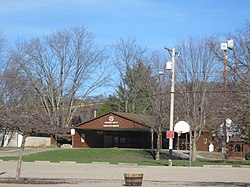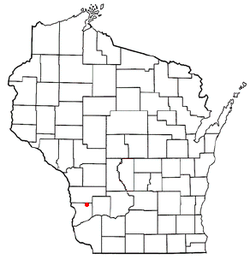Soldiers Grove, Wisconsin
| Soldiers Grove, Wisconsin | |
|---|---|
| Village | |

Soldiers Grove Lions Club Shelter in a public park
|
|
| Nickname(s): America's First Solar Village | |
 Location of Soldiers Grove, Wisconsin |
|
| Coordinates: 43°23′45″N 90°46′20″W / 43.39583°N 90.77222°WCoordinates: 43°23′45″N 90°46′20″W / 43.39583°N 90.77222°W | |
| Country | United States |
| State | Wisconsin |
| County | Crawford |
| Area | |
| • Total | 3.56 sq mi (9.22 km2) |
| • Land | 3.56 sq mi (9.22 km2) |
| • Water | 0 sq mi (0 km2) |
| Elevation | 725 ft (221 m) |
| Population (2010) | |
| • Total | 592 |
| • Estimate (2012) | 583 |
| • Density | 166.3/sq mi (64.2/km2) |
| Time zone | Central (CST) (UTC-6) |
| • Summer (DST) | CDT (UTC-5) |
| Area code(s) | 608 |
| FIPS code | 55-74550 |
| GNIS feature ID | 1574364 |
Soldiers Grove is a village alongside the Kickapoo River in Crawford County, Wisconsin, in the United States. The population was 592 at the 2010 census.
Soldiers Grove was first settled in 1856 by Joseph H. Brightman, who began a sawmill at the site to process logs rafted down the Kickapoo River. The village which sprang up near the sawmill was initially named "Pine Grove" because of the abundance of Eastern White Pine in the vicinity. In 1867, the village's name was changed to "Soldiers Grove" to commemorate the troops who had camped in the area during the Black Hawk War.
In its early years, Soldiers Grove depended upon the Kickapoo River for timber rafting and hydropower for flour and lumber mills. The village's proximity to the river became a liability in the early twentieth century, however, when major floods began to afflict the settlement. Significant flooding occurred in 1907, 1912, 1917, and 1935. Following the last of these incidents, Soldiers Grove and other area communities petitioned the United States Congress to provide funds for a flood control project.
Despite another major flood in 1951, Congress did not agree to a flood control plan until 1962, when it authorized a project that included levees and a flood control dam on the Kickapoo River upstream of Soldiers Grove near La Farge, Wisconsin. Owing largely to environmental concerns, however, construction of the proposed dam was halted partway through construction in 1975 and never finished. In the meantime, a 1974 floodplain zoning ordinance had already taken effect in Soldiers Grove, prohibiting new construction and severely limiting maintenance options near the river and crippling the village's downtown area. Although a levee proposed by the U.S. Corps of Engineers in 1975 would have lessened the restrictions, the village rejected the plan because of costs. While the downtown property was worth approximately $1 million, a levee to protect it would have required $3.5 million to construct and an additional $10,000 a year afterward for annual maintenance.
...
Wikipedia
